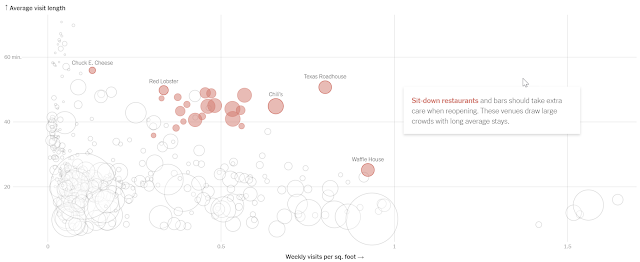Katherine Baicker, Oeindrila Dube, Sendhil Mullainathan, Devin Pope, and
How to use this in class:
1) Show your students how data can inform real-life problems. Or crises, like how to safely re-open stores during COVID-19.
2) Show your students how data can be used in creative ways to solve problems. The present argument uses cellphone location data.
3) Show your students data viz in real life: Here, scatterplots that really improve the #scicomm potential of this piece.
4) Show your students the research process of making an initial argument and then conducting a follow-up study to answer lingering questions.
1) Data to solve problems: This example demonstrates how data can be used in ways it was never intended to inform real-life issues. Here, cell phone location data is being used to create a sort of ratio that might provide guidance in the relative risk associated with different kinds of shopping and stores.
And there is more to be gleaned from this data than is shared via the data visualization, data that argues that industry-wide recommendations may not accurately address the risk associated with different businesses within an industry:
2) Novel data for novel problems: The authors gathered cell phone location data from before COVID-19. A good example of data mining. Here are their methods:
3) The data is presented as a scatterplot+. Why the +? It is interactive in that you can cursor over the circles to see the source of the data. Also, circle size corresponds with the number of locations for a given business. I think that data visualization is a vital tool that helps to clarify and simplify complicated concepts. The use of scatterplots in this article improves communication.
4) Scientific thinking and follow-up studies: The authors realized that their original data looking at a) time spent and b) visits per week x square footage didn't take into account every way the disease spreads. Specifically, the virus can live for a long time on surfaces. As a follow-up study, the authors asked people to estimate a) their level of human interaction/touching of shared surfaces and b) how much of the visit was spent indoors or out of doors. This provides an excellent example of the iterative process of science.





Comments
Post a Comment